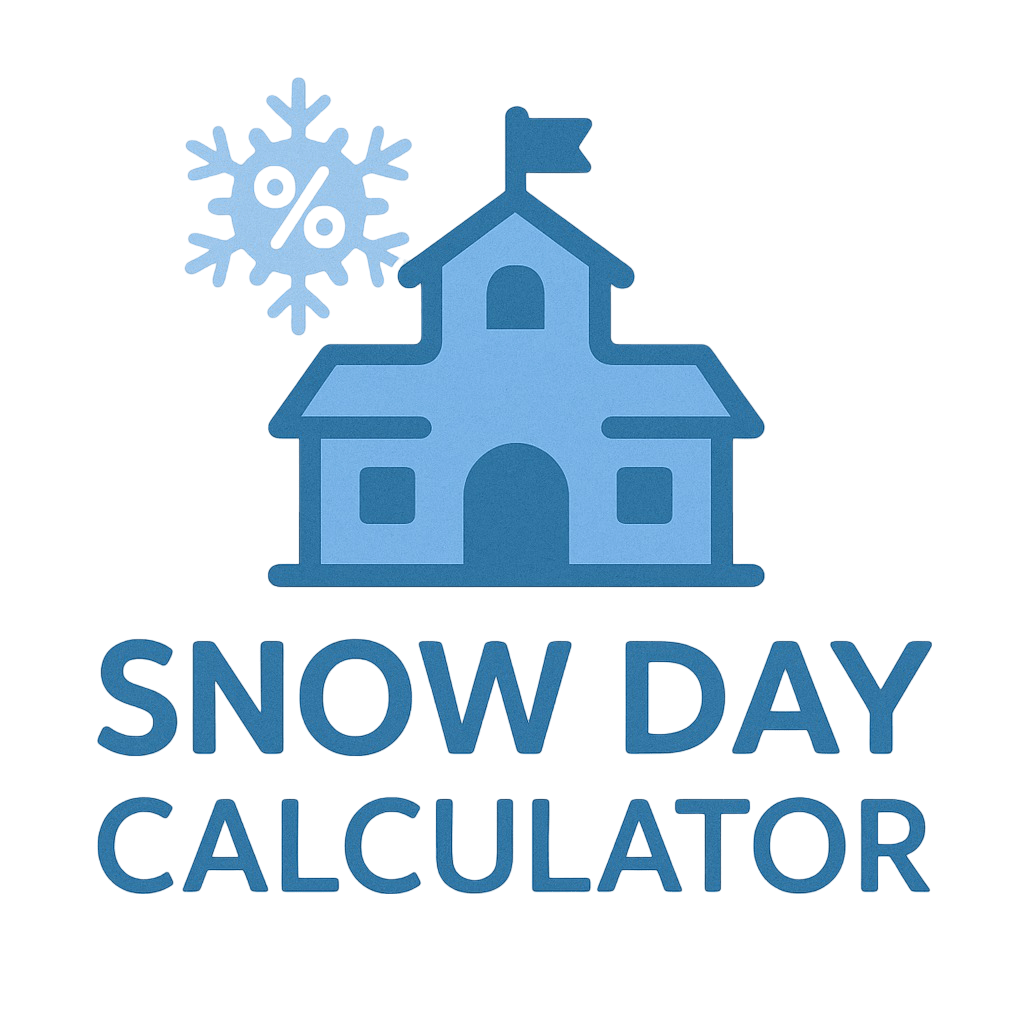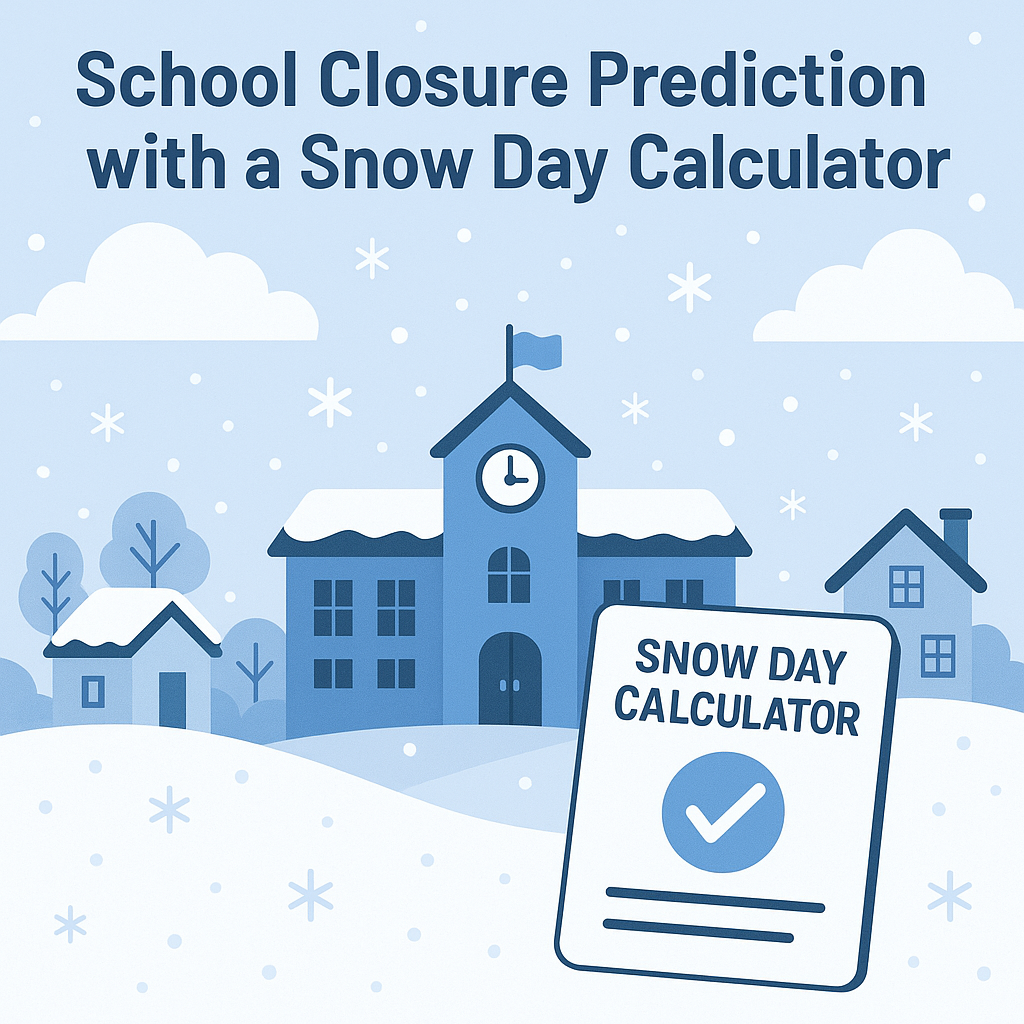1. Introduction
Winter storms spark excitement and uncertainty for students, parents, and teachers awaiting news of potential school closures. School closure prediction tools like the Snow Day Calculator have revolutionized how people anticipate these disruptions. Using advanced technology, these tools forecast the likelihood of a snowy day, helping millions prepare for severe weather. This article explores the mechanics of the Snow Day Calculator and why it’s a trusted resource.
The Growing Curiosity Around Snow Day Prediction Tools
Interest in school closure prediction has soared, especially in snowy regions. Replacing outdated radio announcements, snow day calculators deliver instant, data-driven predictions using real-time weather data and algorithms. Their reliability and ease of use have made them a go-to for millions, reflecting trust in technology to tackle winter weather uncertainty.
How Parents, Students, and Teachers Rely on Them
Snow day calculators are essential for planning. Parents use them to arrange childcare or adjust schedules, students check for potential snow days, and teachers plan lessons or operations. By offering a percentage-based school closure prediction, these tools reduce stress and aid decision-making during storms.
Brief Overview of What the Post Will Explain
This post will reveal how the Snow Day Calculator predicts school closures, analyzing factors like snowfall, temperature, and road conditions using data from sources like the National Weather Service. We’ll cover how AI and machine learning boost accuracy, often up to 90%, and why these tools are valuable for families and schools. We’ll also stress verifying predictions with official school announcements. Let’s uncover how this tool brings clarity to winter chaos.
2. What Is a Snow Day Calculator?
A snow day calculator is an online tool or app that predicts the likelihood of school closures due to winter weather. By analyzing local data like snowfall, temperature, wind speed, and past closure trends, it provides a percentage chance of a snow day, such as “75% chance of closure.” It’s a fun, practical way for students, parents, and teachers to plan for weather-related disruptions.
Why Was the Snow Day Calculator Created?
Snow day calculators were developed to reduce uncertainty during harsh winter weather. They help families plan childcare or transportation by combining weather forecasts, school data, and historical trends for reliable school closure prediction. These tools add science and excitement to the question, “Will school be cancelled tomorrow?”

Popular Snow Day Calculator Used Today
Here are some widely used snow day calculators:
- Snow Day Calculator (snowdaycalculator.com)
- Popular, user-friendly tool using ZIP code and school start time.
- Loved by students for its engaging design.
- Snow Day Predictor
- Uses regional weather models for accurate, real-time predictions.
- TheSnowDayCalculator.xyz
- A newer version with improved algorithm accuracy.
- Offers educational content about how predictions are made.
- Gaining popularity for its clean interface and more realistic results.
These tools are go-to resources during winter storms, helping users stay prepared.
3. How The Snow Day Calculator Works
a. Weather Data Integration
Pulls live forecasts from NOAA, AccuWeather, and local stations. Analyzes temperature, snowfall, wind chill, and precipitation type for accurate predictions.
b. School-Specific Behaviour Modelling
Uses historical school closure data and district decision patterns (rural vs. urban) to tailor predictions based on regional tendencies.
c. Algorithmic Prediction
Employs AI/ML algorithms to process weather and historical data, calculating snow day probabilities with high accuracy (80-95%).
d. Zip Code & Time-Based Personalization
Uses your ZIP code for precise local forecasts and considers school start times and storm timing to better predict the chances of a closure.
✅ Curious about tomorrow? Check your snow day forecast now!
4. Accuracy of School Closure Prediction
Real-World Accuracy
Snow day calculators, like The Snow Day Calculator, typically achieve 80-90% accuracy in predicting school closures, based on historical data and weather forecast integration (NOAA, AccuWeather). Accuracy varies by region and storm complexity.

Weather Variability as a Limiting Factor
Unpredictable weather patterns, such as sudden changes in snowfall intensity, temperature shifts, or microclimates, can reduce accuracy. Last-minute forecast updates may not align with prediction models.
Prediction, Not a Guarantee
These tools use AI/ML and historical school closure patterns to estimate probabilities, not certainties. School district decisions (e.g., rural vs. urban) and unforeseen factors (e.g., road conditions, superintendent discretion) introduce variability, making predictions probabilistic.
5. Who Should Use a Snow Day Calculator?
- Students (Planning and Fun)
- Why: A Snow Day Calculator adds to the excitement by giving students a fun way to check the chances of school being canceled with a simple probability score. It helps them plan activities (e.g., sledding or studying) or manage expectations for the next day.
- Use Case: A student in Buffalo, NY, checks the calculator to see if a big snowstorm might cancel school, so they can plan a day of gaming or catching up on homework.
- Parents (Backup Childcare)
- Why: Parents need to prepare for school closures, especially for arranging childcare or adjusting work schedules. The calculator offers an early indication of a possible snow day, helping families plan ahead and arrange alternatives in advance.
- Use Case: A parent in Chicago uses the calculator to gauge if a snow day is likely, then arranges for a babysitter or remote work to cover childcare needs.
- Teachers/School Staff (Travel Safety)
- Why: Teachers and staff need to plan for safe travel or remote teaching setups. The calculator helps them anticipate closures, reducing the risk of commuting in hazardous conditions or preparing for virtual classes.
- Use Case: A teacher in Minneapolis checks the calculator before a forecasted blizzard to decide whether to bring home grading materials or prepare for a snow day.
Why It’s a Helpful Tool
- Helpful for Planning:
- Early Awareness: The calculator uses weather data and algorithms to predict closure likelihood, giving users a heads-up before official announcements. This allows proactive planning, like rescheduling meetings, arranging childcare, or preparing for remote learning.
- Convenience: It’s quick and accessible, often requiring just a ZIP code and date to generate a percentage chance of a snow day.
- Fun and Engaging: For students, it’s a playful way to engage with weather forecasts, while adults appreciate the practical insights.
- Not an Official Source:
- Predictive, Not Definitive: Snow Day Calculators rely on algorithms and weather models, not direct input from school districts. Actual closures depend on local policies, road conditions, and last-minute decisions by administrators.
- Limitations: Accuracy varies based on the quality of weather data and the calculator’s algorithm. It can’t account for unique district thresholds (e.g., some schools close at 6 inches of snow, others at 12).
- Guidance Only: Users should always check official school announcements (e.g., district websites, emails, or local news) for confirmation, as the calculator is just a planning aid.
6. Tips to Use Snow Day Calculator Effectively
Cross-Check with Weather Apps and Official Channels
- Compare the calculator’s prediction with weather apps (e.g., AccuWeather) and check school websites or X for official closure updates.
- Why: Ensures accurate planning for childcare or travel.

Learn Your District’s Snow Day Trends
- Know how much snow typically closes your school (e.g., 6 inches). Check past closures via news or ask locals.
- Why: Makes the calculator’s probability more relevant.
Set Realistic Expectations (Probability ≠ Guarantee)
- Treat the percentage as a guide, not a sure thing. Prepare for both school open and closed.
- Why: Avoids surprises or disappointment.
7. Frequently Asked Questions (FAQs)
a. Can I rely on a snow day calculator?
This question tackles the reliability of snow day calculators. The answer would likely explain that these tools use algorithms combining weather data (e.g., snowfall predictions, temperature) and regional school closure trends but aren’t foolproof. They provide probabilities, not guarantees, as actual closures depend on decisions by school districts or local authorities. Users should treat them as a helpful guide rather than a definitive source.
b. How often is the data updated?
This addresses the freshness of the calculator’s data. The response would typically note that reputable snow day calculators pull real-time or near-real-time weather data from sources like NOAA or local meteorological services, often updating hourly or daily. However, the exact frequency depends on the specific tool or app, and users should check the calculator’s documentation for details.
c. Does it work outside the US?
This question explores the geographical scope of snow day calculators. The answer would likely clarify that most calculators are designed for regions with frequent snowfall, like the US and Canada, where school closures due to snow are common. Outside the US, functionality may be limited due to differences in weather patterns, school policies, or data availability. Some global apps might work in snowy regions (e.g., parts of Europe or Asia) if they integrate local weather data, but accuracy could vary.
d. What’s the best snow day app for students?
This seeks recommendations for student-friendly apps. The response might highlight popular options (e.g., Snow Day Calculator, School Closures, or local weather apps with closure predictions) based on ease of use, accuracy, and features like notifications or school-specific data. It would emphasize apps that are free or affordable, visually engaging, and tailored to student needs, while noting that “best” depends on the user’s location and preferences.
8. Conclusion
Recap how snow day calculators work:
This part reiterates that snow day calculators analyze weather forecasts (e.g., snowfall amount, timing, temperature) alongside historical school closure data and sometimes user-input details (e.g., zip code, school district). They generate a percentage likelihood of a snow day using proprietary algorithms, often presented in a fun, user-friendly format.
Emphasize their predictive, not definitive, nature:
The conclusion stresses that these tools are not authoritative. School closure decisions are made by officials based on real-time conditions, safety concerns, and local policies, which calculators can’t fully account for. Predictions may be inaccurate due to sudden weather changes or human factors.
Encourage use for fun + planning, but check official sources:
It encourages users, especially students, to enjoy snow day calculators as a playful way to anticipate potential school closures and plan (e.g., for studying or snow-day activities). However, it urges them to verify closures through official channels like school websites, local news, or district notifications to avoid misinformation.


3 thoughts on “How Reliable Is School Closure Prediction with a Snow Day Calculator”